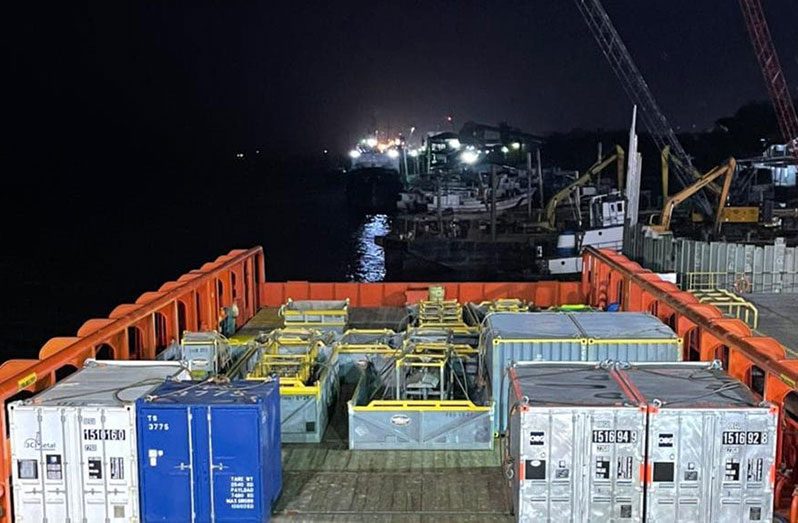–as equipment, technical experts arrive in Guyana
INCREASED gas-flaring at ExxonMobil’s Liza Destiny floating production sharing and offloading (FPSO) vessel offshore Guyana is anticipated to be reduced very soon, as the company has acquired the repaired and upgraded flash gas compressor that was previously damaged.
This compressor was damaged in January and resulted in the company having to temporarily increase gas-flaring above pilot levels in order to maintain safe operations. Subsequently, the company removed the faulty compressor and sent it for repairs in Germany.
According to a statement issued by ExxonMobil on Saturday, the repaired and upgraded flash gas compressor and silencers for the Liza Destiny FPSO have arrived offshore Guyana for reinstallation. The critical part arrived on target, since the company had previously said that the equipment should be back in Guyana by March.
ExxonMobil said too that not only is the part here, but the necessary technical experts have also arrived in country after being appropriately tested and isolated in novel coronavirus (COVID-19) quarantining facilities. They will support experts in the country with the reinstallation.
Although the issue will be resolved shortly, an order has been placed for a new flash gas compressor, which will be available closer to the end of the year, given the complex nature of the equipment. Previously, ExxonMobil had said that production levels at its operations offshore Guyana have been reduced in order to accommodate the repair of the defective gas compressor. It was noted that the company continues to produce oil at 120,000 barrels per day, while the current daily levels of flaring are between 16 to 18 million cubic feet.
But the company had said that reducing production would not necessarily limit the amount of gas that is being flared.
“In order for us to get back to pilot-flaring levels, we need that flash gas compressor or we need to reduce production to zero… that’s just a fact,” ExxonMobil’s Production Manager Mike Ryan had said in a previous report.
Back in 2019, ExxonMobil had explained to the media that for the first period, after ‘first oil,’ there would be initial start-up flaring as authorised by the Environmental Protection Agency (EPA), which occurs during the commissioning and initial start-up phases of the FPSO when gas and liquids are introduced into new facilities and equipment.
This flaring, it said, would not continue as a routine, and would only take place again in the case of an emergency, whereby flaring will be used to immediately de-pressure the facility as part of a shut-down process to reduce risk.
Executive Director of the Payne Institute for Earth Resources and Research, Professor of Public Policy at the Colorado School of Mines, Dr. Morgan Bazilian, had said that general regulatory and technical measures must be implemented to mitigate gas-flaring in future projects.
“Yes, flaring itself has environmental impacts, and is a waste of resources, economically and environmentally bad,” said Dr. Bazilian during a virtual session with local reporters in October 2020.
He further added that there are technical ways to reduce flaring, but there must be a combination of technical measures which will come in quickly, and regulatory measures. Most countries take “a long time” to develop a regulatory framework for gas-flaring, but from the expert’s understanding, the projects in Guyana are engineered to have zero routine flaring.
Dr. Bazilian pointed to the “Zero Routine Flaring by 2030” initiative introduced by the World Bank, which brings together governments, oil companies, and development institutions which recognise the dangers of flaring. According to the World Bank, this initiative pertains to ‘routine flaring’, and not to ‘flaring’ for safety reasons or non-routine flaring, which, nevertheless, should be minimised.
“Routine flaring of gas is flaring during normal oil production operations in the absence of sufficient facilities, or amenable geology to re-inject the produced gas, utilise it on-site, or dispatch it to a market. Venting is not an acceptable substitute for flaring,” said the World Bank.
According to the World Bank, during oil production, associated gas is produced from the reservoir together with the oil; much of this gas is utilised or conserved, because governments and oil companies have made substantial investments to capture it, but some of it is flared because of technical, regulatory, or economic constraints.
Dr. Bazilian said gas-flaring is controlled through power plants, or reinjection into wells, and in Guyana’s case, while ExxonMobil has started reinjection, there are already talks locally to establish a gas-to-energy system.



.jpg)









